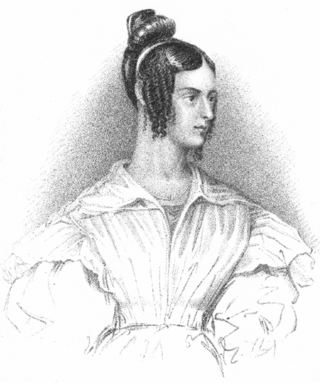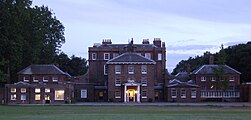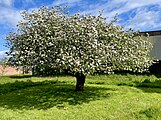
William IV was King of the United Kingdom of Great Britain and Ireland and King of Hanover from 26 June 1830 until his death in 1837. The third son of George III, William succeeded his elder brother George IV, becoming the last king and penultimate monarch of Britain's House of Hanover.

Adelaide of Saxe-Meiningen was Queen of the United Kingdom of Great Britain and Ireland and Queen of Hanover from 26 June 1830 to 20 June 1837 as the wife of King William IV. Adelaide was the daughter of George I, Duke of Saxe-Meiningen, and Luise Eleonore of Hohenlohe-Langenburg. Adelaide, the capital city of South Australia, is named after her.

The National Physical Laboratory (NPL) is the national measurement standards laboratory of the United Kingdom. It sets and maintains physical standards for British industry.

St James's Palace is the most senior royal palace in London, the capital of the United Kingdom. The palace gives its name to the Court of St James's, which is the monarch's royal court, and is located in the City of Westminster in London. Although no longer the principal residence of the monarch, it is the ceremonial meeting place of the Accession Council, the office of the Marshal of the Diplomatic Corps, and the London residence of several members of the royal family.

Clarence House is a royal residence on The Mall in the City of Westminster, London. It was built in 1825–1827, adjacent to St James's Palace, for the royal Duke of Clarence, the future King William IV.

Bushy Park in the London Borough of Richmond upon Thames is the second largest of London's Royal Parks, at 445 hectares in area, after Richmond Park. The park, most of which is open to the public, is immediately north of Hampton Court Palace and Hampton Court Park and is a few minutes' walk from the west side of Kingston Bridge. It is surrounded by Teddington, Hampton, Hampton Hill and Hampton Wick and is mainly within the post towns of Hampton and Teddington, those of East Molesey and Kingston upon Thames taking the remainder.

George Montagu-Dunk, 2nd Earl of Halifax, was a British statesman of the Georgian era. Due to his success in extending commerce in the Americas, he became known as the "father of the colonies". President of the Board of Trade from 1748 to 1761, he aided the foundation of Nova Scotia, 1749, the capital Halifax being named after him. When Canada was ceded to the King of Great Britain by the King of France, following the Treaty of Paris of 1763, he restricted its boundaries and renamed it "Province of Quebec".

Henry Bathurst, 2nd Earl Bathurst, known as The Lord Apsley from 1771 to 1775, was a British lawyer and politician. He was Lord High Chancellor of Great Britain from 1771 to 1778.
The Office of Works was established in the English royal household in 1378 to oversee the building and maintenance of the royal castles and residences. In 1832 it became the Works Department forces within the Office of Woods, Forests, Land Revenues, Works and Buildings. It was reconstituted as a government department in 1851 and became part of the Ministry of Works in 1940.
This is a list of people who have served as Lord Lieutenant of Surrey. Since 1737, all Lords Lieutenant have also been Custos Rotulorum of Surrey.
George Montagu, 1st Earl of Halifax, of Horton, Northamptonshire, was a British politician who sat in the House of Commons from 1705 to 1715 when he became a peer.
Lord William Powlett was an English Member of Parliament.

White Lodge is a Grade I listed Georgian house situated in Richmond Park, in the London Borough of Richmond upon Thames. Formerly a royal residence, it now houses the Royal Ballet Lower School, instructing students aged 11–16.

Amelia Cary, Viscountess Falkland, was a British noblewoman. She was born the fifth illegitimate daughter of William IV of the United Kingdom by his long-time mistress Dorothea Jordan. Amelia had four sisters and five brothers, all surnamed FitzClarence. Soon after their father became monarch, the FitzClarence children were raised to the ranks of younger children of a marquess. A granddaughter of George III, Amelia was named after her aunt Princess Amelia.

Teddington is an affluent suburb of London in the London Borough of Richmond upon Thames. Historically an ancient parish in the county of Middlesex and situated close to the border with Surrey, the district became part of Greater London in 1965. In 2021, The Sunday Times named Teddington as the best place to live in London.

Edward Proger was a Member of Parliament for Brecknockshire/Breconshire, Page of Honour to King Charles I, Groom of the Bedchamber for King Charles II and Lord of the Manor of West Stow. He was Keeper of the Middle Park and Harewarren for 48 years.

The Upper Lodge Water Gardens are a partially restored complex of early eighteenth century water gardens with garden canals in Bushy Park, near London. Originally built for Charles Montagu, 1st Earl of Halifax between 1709 and 1715 when he was ranger of Bushy Park and lived in Upper Lodge, they fell into disuse over subsequent centuries, but part of the complex was restored in the early 21st century and opened to the public in 2009.

Sir William Humfreys, 1st Baronet, was a British ironmonger and politician who sat in the House of Commons from 1715 to 1722. He was Lord Mayor of London for 1714–15 and a Director of the Bank of England between 1719 and 1730.

Lady Augusta Gordon was a British noblewoman. Born the fourth illegitimate daughter of William IV of the United Kingdom by his long-time mistress Dorothea Jordan, she grew up at their Bushy House residence in Teddington. Augusta had four sisters and five brothers all surnamed FitzClarence. Soon after their father became monarch, the FitzClarence children were raised to the ranks of younger children of a marquess.
Richmond Lodge was a historic property located near the River Thames in Richmond, London, in what is now known as Old Deer Park, lands belonging to the historic Richmond Palace. It was located close to the King's Observatory. It should not be confused with Pembroke Lodge or the White Lodge, both in Richmond Park, or a variety of other similarly named properties.






















